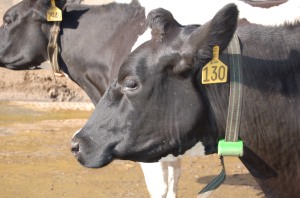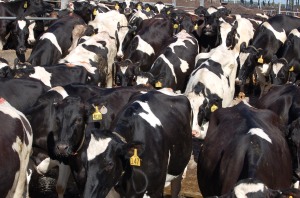October 2022 update: Due to damage from Hurricane Ian, Dakin Dairy Farm continues to recover and rebuild. The farm market is open and has a limited menu for lunch. Tours will resume when possible. Check out the Dakin Dairy Farm website or Facebook page for updates.
It’s not easy to make one of nature’s most perfect foods in Florida.
The state’s famous heat makes it hard to raise dairy cows to produce milk. Or in the words of Dakin Farm co-owner Karen Dakin, “The cows are hot, wet, and muddy in the summer.” 
The challenges of dairy farming, along with the cost of increasing federal regulations, are major reasons why the number of dairy farms in Florida reduced by half in a few short years–from more than 300 to now fewer than 150. In Southwest Florida’s Manatee County, the number of dairy farms has decreased from 40 to only three, all three of which are run by the Dakin family.
With this in mind, Dakin Farm in rural Myakka City has created a niche for itself with its 24/7 all-natural sustainable dairy operation and its growing fame as an agro-tourism destination.
What also makes the farm unique is that its cows are grass fed instead of fed hay or grains. It’s easy to grow grass year-round in Florida, so the cows always have a fresh supply of tender grass mixed with other nutrients such as citrus pulp, which is taken from the local abundance of citrus.
Grass feeding the cows adds a different flavor to the milk and provides natural cancer fighting compounds to those who drink it. “The milk has a smooth creamy texture and there’s more body to it,” says Dakin, a Washington, D.C.-area native and a telecommunications company vp turned farmer. She and her husband have run the farm at the Myakka City location since 2002, but her husband’s family has been involved in farming since the 1940s.
Down on the Farm
Arriving at Dakin Dairy Farm on a recent Saturday–the day when the farm is open to the public (the farm shepherds about 250 tour group and schoolchildren through on weekdays)–you may think you’re on a farm in Anywhere, America, except for the two wide palm trees found at the entrance to the farm’s market. Farmhands drive around in golf carts, most wearing camouflage clothing and Dakin Farm baseball caps.
For $2 general admission, visitors can feed the goats (25 cents for a feed bag), roast hot dogs or marshmallows, host birthday parties, dig for “fossils,” ride the swings that hang from trees, complete a child-size or big kid-size corn maze, bring a picnic, play on the playground, get dirty on a massive mound of sand topped by John Deere toy trucks, or visit the petting zoo, which includes calves, roosters, turkeys, guineas, and pigs. This and the tour are all available October through April, as the Florida heat makes public visits more uncomfortable the rest of the year.
A sign outlining the farm rules reminds visitors to be careful and to not climb trees or climb on top of the hay. “NO BROKEN BONES PLEASE,” the sign warns. That warning seems directed right at me as my son broke his leg on a farm when he was three.
A farm tour ($6) and hayride ($2) give a glimpse of the farm’s real action. Today’s tour is led by the enthusiastic Kim O’Brien of Myakka City, who has been giving tours since the farm opened to the public three years ago. At the start of the tour, O’Brien points out an intimidating mound of compost made with 50% cow’s manure (if you didn’t see the pile, the smell would give it away).

She then leads a group of about 10 of us to a barn where many cows reside. The barn has a specially designed roof with a slant that helps keep the cows cooler in the summer. As it gets hotter, the cows don’t eat as much and don’t produce as much. “We want to keep them cool, comfortable, and well fed,” Dakin says.
Dakin Farm has about 3,000 cows total, including calves, Heifers (cows that have not had babies yet–they cannot produce milk until they have a child), and bulls. The farm uses a color marking system on the cows’ backs along with a microchip and numbers attached to their ears to keep track of which cows are part of which herd, how much milk they’re producing, and more. The farm uses the cows for milk until they’re around 10 years old, at which time they tend to eat less and produce less. At that point they’re usually sold to fast food chains for beef.
About 1,400 cows are milked three times a day in an eight-hour cycle. “We have to milk no matter what the weather, otherwise it’s painful for them,” O’Brien says. The cows spend their day eating–an average of 65 lbs a day–and resting. When it is time to get ready for milking, they move in a surprisingly organized fashion to a communal shower that has 96 shower heads. The showers help prevent the spread of bacteria and help rid the cows of bugs, O’Brien explains.

Fifty cows at a time are hooked up to an appartatus that allows two to three employees to milk them in seven minutes. A simple whistle signals to the cows that they’re done, and the next group slowly moves in for milking. Each cow averages seven gallons a day. The cows produce more than 70,000 gallons of milk a week, says Dakin (if Dakin and her husband use milk produced by the cows at her brother-in-laws’ farms, they can produce up to 200,000 gallons a week). Every 19 hours, the farm ships 7,000 gallons of milk to Miami, and that milk becomes part of the pool of milk from various farms sold by Velda Farms.
Merely 75 feet away from the milking area is the processing plant, which includes an area to pasteurize the milk to kill bacteria, homogenization to remove the cream, and bottling. The bottling machine’s conveyor belt can bottle 90 half-gallons in one minute. The total process takes 13 to 15 hours, O’Brien says.
Honing in on Locally Owned
Dakin Farm’s milk is available in the area at Sweetbay Supermarket, Whole Foods Market, and a variety of local farmers’ markets. Karen Dakin hopes to delve soon into making cheese and butter. Although not a “megafarm,” Dakin has made the leap from a niche product to one that is commercially available, which makes marketing and pricing much more competitive, she says.
Although Dakin Farm is not certified organic–a designation which can be costly to obtain–Karen Dakin says the farm has a growing customer base because the product is locally made and produced in a manner that is as natural and sustainable as possible for a large farm. These are both trends of interest to a number of consumers. “People want to know where their food is coming from,” she said. “We are transparent. People can come and see us.”
The locally-owned angle may be of special interest to milk lovers in Florida, where the dairy shortage is so critical that milk in Northern Florida is often brought in from Georgia and Alabama, O’Brien says. In turn, those in Central Florida generally drink milk produced by cows in Northern Florida, and those in South Florida generally drink milk produced by cows in Central Florida, she adds. “We are a dairy-deficient state,” she says.
The farm is also part of a push for agro-tourism within Manatee and Sarasota counties, Dakin says. A new group called Gulf Coast Ag Ventures is encouraging visitors to come see a variety of local farms and other food producers, similar to the agriculture and winery tours popular in California and New England.

Leave a comment